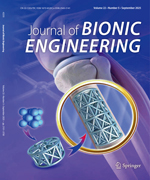|
|
Recent Advances of Chimp Optimization Algorithm: Variants and Applications
Mohammad Sh. Daoud, Mohammad Shehab, Laith Abualigah, Mohammad Alshinwan, Mohamed Abd Elaziz, Mohd Khaled Yousef Shambour, Diego Oliva, Mohammad A. Alia & Raed Abu Zitar
Journal of Bionic Engineering. 2023, 20 (6):
2840-2862.
DOI: 10.1007/s42235-023-00414-1
Chimp Optimization Algorithm (ChOA) is one of the recent metaheuristics swarm intelligence methods. It has been widely
tailored for a wide variety of optimization problems due to its impressive characteristics over other swarm intelligence
methods: it has very few parameters, and no derivation information is required in the initial search. Also, it is simple, easy
to use, fexible, scalable, and has a special capability to strike the right balance between exploration and exploitation during
the search which leads to favorable convergence. Therefore, the ChOA has recently gained a very big research interest with
tremendous audiences from several domains in a very short time. Thus, in this review paper, several research publications
using ChOA have been overviewed and summarized. Initially, introductory information about ChOA is provided which
illustrates the natural foundation context and its related optimization conceptual framework. The main operations of ChOA
are procedurally discussed, and the theoretical foundation is described. Furthermore, the recent versions of ChOA are dis�cussed in detail which are categorized into modifed, hybridized, and paralleled versions. The main applications of ChOA
are also thoroughly described. The applications belong to the domains of economics, image processing, engineering, neural
network, power and energy, networks, etc. Evaluation of ChOA is also provided. The review paper will be helpful for the
researchers and practitioners of ChOA belonging to a wide range of audiences from the domains of optimization, engineer�ing, medical, data mining, and clustering. As well, it is wealthy in research on health, environment, and public safety. Also,
it will aid those who are interested by providing them with potential future research.
Related Articles |
Metrics
|

 Table of Content
Table of Content
 Table of Content
Table of Content